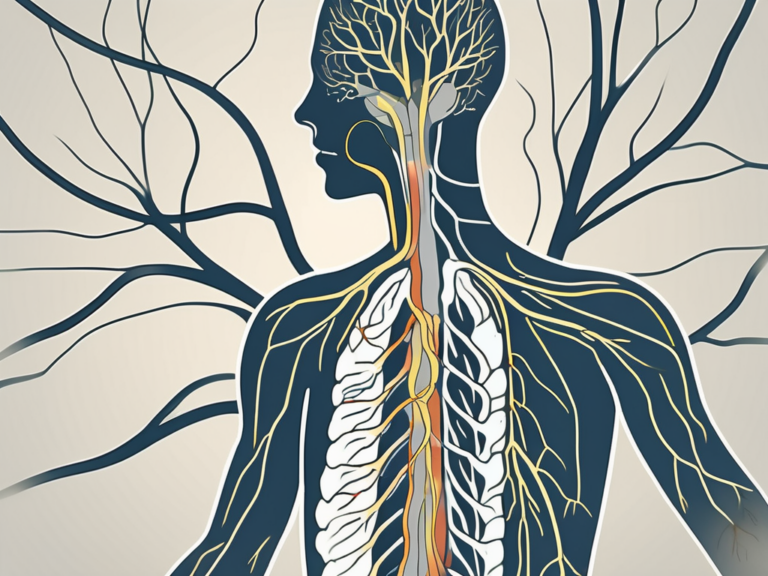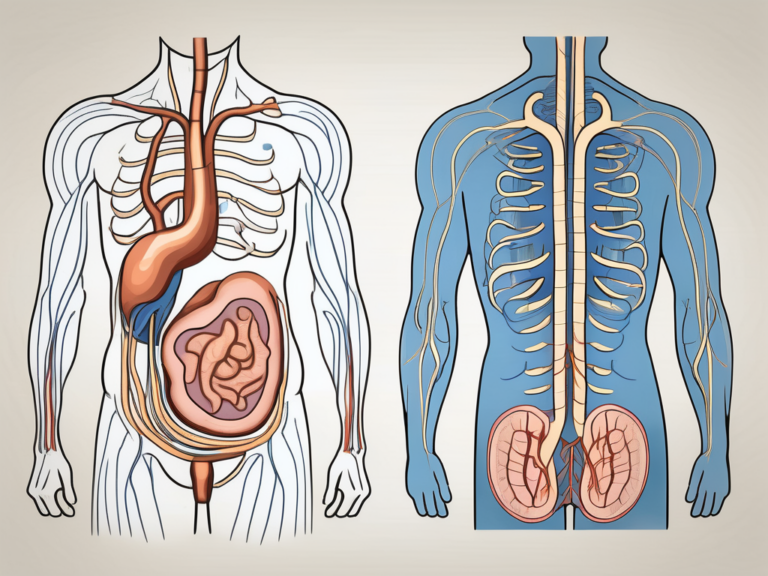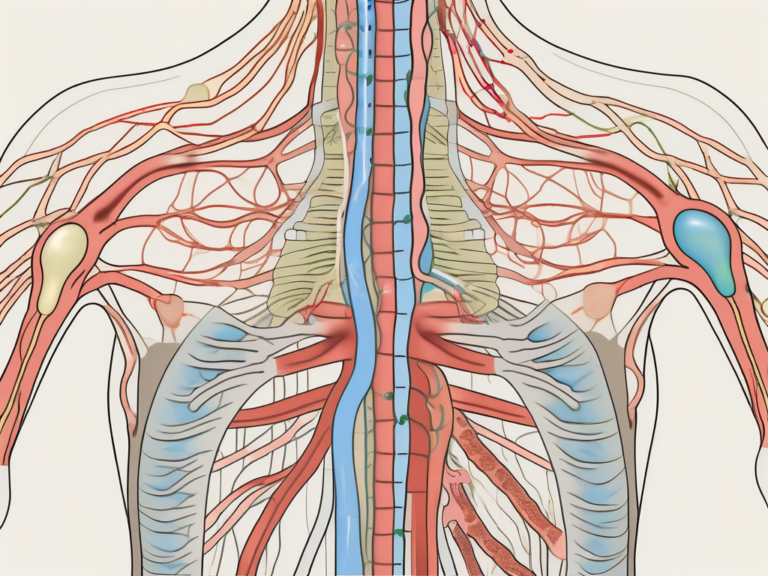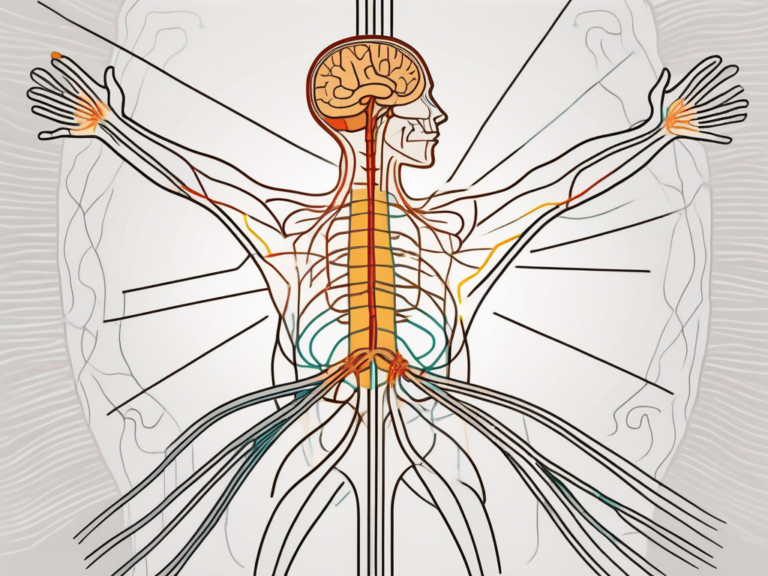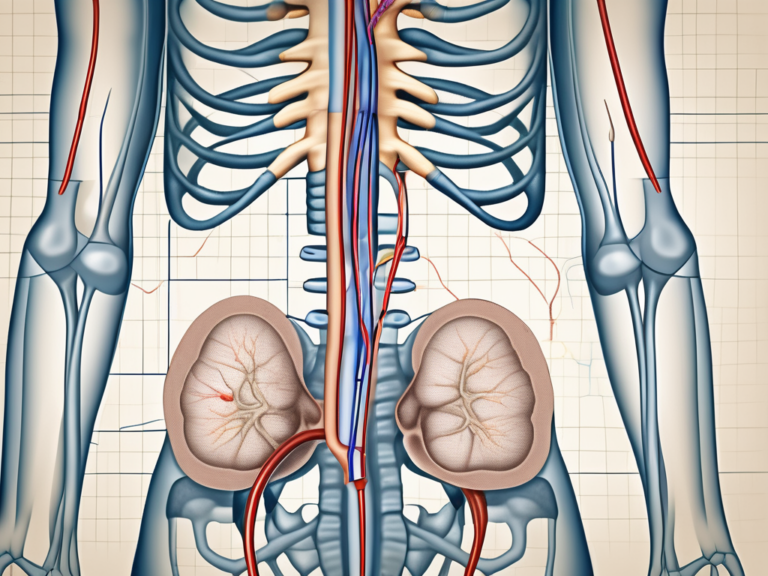What Nerve Arises from the Sacral Plexus?
The sacral plexus is a complex network of nerves located in the pelvis. It plays a crucial role in connecting the lower limbs to the central nervous system. Understanding the sacral plexus and its associated nerves, such as the sciatic nerve, is important for comprehending various conditions related to this region. In this article, we will delve into the anatomy of the sacral plexus, explore the functions of these nerves, examine disorders that can affect them, and discuss treatment options that may be available.
Understanding the Sacral Plexus
Anatomy of the Sacral Plexus
The sacral plexus is formed by the fusion of several spinal nerves originating from the lower back. Specifically, the nerves involved are the fourth and fifth lumbar nerves (L4, L5) and the first to fourth sacral nerves (S1-S4). As these nerves merge, they create a complex network that supplies motor and sensory innervation to the pelvis and lower limbs.
The fourth and fifth lumbar nerves (L4, L5) are responsible for transmitting signals from the lower back and abdomen. These nerves play a crucial role in providing sensation and motor control to the lower extremities. They are involved in movements such as walking, running, and maintaining balance.
The first to fourth sacral nerves (S1-S4) originate from the sacrum, the triangular bone at the base of the spine. These nerves branch out and innervate various muscles and organs in the pelvic region. They are responsible for transmitting signals related to bowel and bladder control, sexual function, and sensation in the buttocks and perineum.
Together, the lumbar and sacral nerves form the sacral plexus, a complex web of nerve fibers that intertwine and communicate with each other. This intricate network ensures efficient transmission of signals between the brain and the lower extremities, allowing for coordinated movement and sensory perception.
Functions of the Sacral Plexus
The sacral plexus is involved in numerous functions, including motor control and sensation in the pelvic region, buttocks, and legs. It provides innervation to the hip joint, knee joint, and various muscles that allow movement and stability in these areas.
One of the key nerves arising from the sacral plexus is the sciatic nerve. The sciatic nerve is the largest nerve in the body and is responsible for transmitting sensory information and controlling muscle movement in the leg. It originates from the lower back, passes through the buttock, and extends down the back of the thigh, branching out to innervate the muscles of the lower leg and foot.
In addition to its role in motor control, the sacral plexus plays a crucial role in controlling bowel and bladder function. The nerves within the plexus transmit signals that regulate the contraction and relaxation of the muscles involved in these processes. Dysfunction of the sacral plexus can lead to conditions such as urinary incontinence and fecal incontinence.
Furthermore, the sacral plexus is involved in sexual function. The nerves within the plexus transmit signals that contribute to sexual arousal, orgasm, and ejaculation in males, and clitoral erection and vaginal lubrication in females. Dysfunction of the sacral plexus can result in sexual dysfunction and reproductive issues.
In conclusion, the sacral plexus is a complex network of nerves that plays a vital role in motor control and sensation in the pelvis and lower limbs. Understanding its anatomy and functions is essential for comprehending the significance of this intricate neural structure.
The Nerve that Arises from the Sacral Plexus
The sacral plexus, a complex network of nerves located in the lower back, gives rise to several important nerves that innervate the lower limbs. One of the major nerves originating from the sacral plexus is the sciatic nerve. The sciatic nerve is a thick and robust nerve that plays a crucial role in the functioning of the leg.
Characteristics of the Sciatic Nerve
The sciatic nerve is formed by the convergence of fibers from the fourth and fifth lumbar nerves and the first to fourth sacral nerves. This amalgamation of nerve fibers creates a formidable nerve that is essential for the proper functioning of the lower limb.
Originating in the lower back, the sciatic nerve extends down through the buttocks and travels along the back of the thigh. As it courses through the leg, it gives off various branches that supply different regions of the lower limb. These branches ensure that the leg receives the necessary sensory input and motor control.
As a mixed nerve, the sciatic nerve carries both sensory and motor fibers. Sensory fibers transmit information such as pain, temperature, and touch from the leg to the brain. This allows us to perceive and respond to various stimuli in our environment. On the other hand, motor fibers control the movement of several leg muscles, enabling us to perform activities such as walking, running, and jumping with ease and coordination.
Role and Function of the Sciatic Nerve
The sciatic nerve plays a vital role in providing motor function and sensory perception to the leg. Without the sciatic nerve, the leg would be devoid of the ability to move and sense the environment around it.
Motor function is one of the primary responsibilities of the sciatic nerve. It transmits signals from the brain to the leg muscles, allowing us to perform a wide range of movements. Whether it’s the simple act of walking or the complex coordination required for sports activities, the sciatic nerve ensures that the leg muscles receive the necessary instructions to carry out these actions.
In addition to motor function, the sciatic nerve also carries sensory information back to the brain. This allows us to perceive sensations such as pain, temperature, and touch in the leg. By relaying these sensory signals, the sciatic nerve enables us to respond appropriately to stimuli and protect ourselves from potential harm.
However, it is important to note that the sciatic nerve is vulnerable to damage or compression, which can lead to significant pain and dysfunction in the leg. Conditions such as sciatica, characterized by pain radiating down the leg, are often the result of irritation or compression of the sciatic nerve. This can occur due to various factors, including herniated discs, muscle imbalances, or even prolonged sitting in a position that puts pressure on the nerve.
In conclusion, the sciatic nerve, originating from the sacral plexus, is a vital nerve that provides motor function and sensory perception to the leg. Its intricate network of fibers allows for the transmission of signals between the brain and leg muscles, enabling us to move and perform various activities. Additionally, it carries sensory information back to the brain, allowing us to perceive sensations and respond accordingly. Understanding the characteristics and functions of the sciatic nerve is crucial in recognizing and addressing any issues that may arise, ensuring the optimal functioning of the lower limb.
Connection between the Sacral Plexus and Sciatic Nerve
How the Sciatic Nerve Originates from the Sacral Plexus
The sciatic nerve, one of the largest nerves in the human body, originates from the sacral plexus through the fusion of nerve fibers from the L4 to S3 spinal nerves. This intricate network of nerves forms within the pelvis, specifically between the piriformis muscle and the ischium bone. It is fascinating to think about how these nerve fibers come together, intertwining and merging to create the sciatic nerve.
As the sciatic nerve emerges from its origin point, it embarks on a remarkable journey down the back of the thigh. It is truly awe-inspiring to consider the complexity of the human body and the intricate pathways that nerves like the sciatic nerve take to reach their destinations. The fusion of nerve fibers from multiple spinal nerves ensures that the sciatic nerve carries a wide range of signals and commands to various parts of the leg.
Upon its emergence, the sciatic nerve branches out into smaller nerves that supply the leg muscles. These branches allow for precise and coordinated movement, enabling us to walk, run, and perform countless other activities that involve the use of our legs. It is truly remarkable how the sciatic nerve, with its numerous branches, facilitates the intricate interplay between our muscles and the nervous system.
The Pathway of the Sciatic Nerve
As the sciatic nerve descends down the thigh, it embarks on a fascinating journey, sending branches to various muscles along the way. These branches provide essential innervation to important muscle groups such as the hamstrings, quadriceps, and calf muscles. Without the sciatic nerve, the coordination and function of these muscles would be severely compromised.
Additionally, the sciatic nerve plays a crucial role in sensory innervation. It provides sensory signals to the skin of the leg and foot, allowing us to perceive touch, temperature, and pain in these areas. The intricate network of sensory fibers within the sciatic nerve ensures that we can experience the world around us through the sensations we feel on our legs and feet.
It is important to note that the pathway of the sciatic nerve can vary slightly among individuals. While the general trajectory remains consistent, some variations may occur within the pelvis and the thigh. This variability highlights the uniqueness of each human body and serves as a reminder of the intricacies of our nervous system.
In conclusion, the connection between the sacral plexus and the sciatic nerve is a marvel of human anatomy. The fusion of nerve fibers from multiple spinal nerves gives rise to the sciatic nerve, which then embarks on a complex journey down the thigh, branching out to supply the leg muscles and providing sensory innervation to the skin. Understanding the intricate details of this connection allows us to appreciate the remarkable complexity and functionality of the human body.
Potential Disorders Related to the Sacral Plexus and Sciatic Nerve
Common Conditions Affecting the Sacral Plexus
Several conditions can affect the sacral plexus, leading to pain and dysfunction in the pelvis and lower limbs. These conditions include sacroiliac joint dysfunction, piriformis syndrome, and lumbar radiculopathy. The sacroiliac joint is located at the junction of the sacrum and the ilium, and dysfunction in this joint can cause pain and discomfort in the lower back, buttocks, and legs. Piriformis syndrome occurs when the piriformis muscle, located deep in the buttocks, becomes tight or spasms, compressing the sciatic nerve and causing pain. Lumbar radiculopathy refers to the compression or irritation of the nerve roots in the lower back, leading to pain, numbness, and weakness in the legs.
When experiencing symptoms related to the sacral plexus, it is crucial to consult with a healthcare professional to accurately diagnose and manage these conditions. The healthcare professional will conduct a thorough physical examination, review the patient’s medical history, and may order additional diagnostic tests such as X-rays, MRI, or nerve conduction studies. Treatment approaches can vary depending on the specific underlying cause of the sacral plexus disorder. It may include physical therapy, medications, injections, or in severe cases, surgery.
Sciatic Nerve Disorders and Symptoms
Sciatica is one of the most well-known disorders associated with the sciatic nerve. It typically manifests as sharp or shooting pain that radiates from the lower back, through the buttocks, and down the back of the leg. The sciatic nerve is the longest nerve in the body, running from the lower back, through the buttocks, and down the legs. When the sciatic nerve becomes compressed or irritated, it can cause a variety of symptoms. In addition to pain, individuals with sciatic nerve disorders may experience numbness, tingling, and weakness in the leg.
There are several potential causes of sciatic nerve disorders, including herniated discs, spinal stenosis, degenerative disc disease, and piriformis syndrome. Herniated discs occur when the soft inner material of a spinal disc pushes out through a crack in the tough outer layer, putting pressure on the sciatic nerve. Spinal stenosis refers to the narrowing of the spinal canal, which can compress the nerves, including the sciatic nerve. Degenerative disc disease is a condition where the spinal discs gradually wear down over time, leading to instability and nerve compression. Piriformis syndrome, as mentioned earlier, occurs when the piriformis muscle compresses the sciatic nerve.
If you suspect you have a sciatic nerve disorder, it is essential to seek medical advice for the evaluation and management of your condition. A healthcare professional will perform a comprehensive examination, which may include physical tests to assess your strength, sensation, and reflexes. Imaging studies, such as X-rays or MRI, may also be ordered to visualize the spine and identify any structural abnormalities. Treatment for sciatic nerve disorders may involve pain management techniques, physical therapy, medication, or in severe cases, surgery.
Treatment and Management of Sacral Plexus and Sciatic Nerve Disorders
The sacral plexus and sciatic nerve are vital components of the human body, responsible for connecting the lower limbs to the central nervous system. When these structures are affected by disorders, it can lead to debilitating symptoms and a decrease in quality of life. Fortunately, there are various treatment options available to manage these conditions and provide relief.
Non-Surgical Treatment Options
Non-surgical interventions are often the first line of treatment for sacral plexus and sciatic nerve disorders. These approaches aim to alleviate symptoms and improve function without the need for invasive procedures. One of the most commonly recommended non-surgical treatments is physical therapy. This involves targeted exercises and stretches designed to strengthen the muscles surrounding the affected nerves and improve flexibility. Physical therapy can also help to reduce inflammation and promote healing.
In addition to physical therapy, pain medications may be prescribed to manage discomfort associated with sacral plexus and sciatic nerve disorders. These medications can range from over-the-counter nonsteroidal anti-inflammatory drugs (NSAIDs) to stronger prescription painkillers, depending on the severity of the symptoms. It is important to note that pain medications should be used under the guidance of a healthcare professional to minimize potential side effects and ensure proper dosage.
Heat and cold therapy is another non-surgical treatment option that can provide temporary relief from pain and inflammation. Applying a heating pad or warm compress to the affected area can help to relax muscles and improve blood flow, while cold packs can numb the area and reduce swelling. Alternating between heat and cold therapy can be an effective way to manage symptoms and promote healing.
Lifestyle modifications can also play a crucial role in the treatment and management of sacral plexus and sciatic nerve disorders. Making changes to daily habits, such as maintaining good posture, avoiding prolonged sitting or standing, and incorporating regular exercise into the routine, can help to alleviate symptoms and prevent further aggravation of the nerves. Additionally, weight management and a healthy diet can contribute to overall well-being and reduce the strain on the affected area.
A healthcare professional will determine the most appropriate treatment plan based on the individual’s specific condition and symptoms. They will take into account factors such as the underlying cause of the disorder, the severity of symptoms, and the patient’s overall health and lifestyle. It is important to follow the recommended treatment plan and communicate any changes or concerns to the healthcare provider for optimal outcomes.
Surgical Interventions for Severe Cases
In severe cases where conservative measures have not provided adequate relief, surgical interventions may be considered. These interventions are typically reserved for cases where other treatment options have been exhausted or when there is significant nerve dysfunction. Surgical procedures for sacral plexus and sciatic nerve disorders can vary depending on the specific condition and underlying cause.
One common surgical intervention is nerve decompression, which involves removing any structures that may be compressing or impinging on the affected nerves. This can help to alleviate pain and restore normal nerve function. In some cases, damaged nerves may need to be repaired or replaced to restore proper communication between the lower limbs and the central nervous system.
It is important to note that surgical interventions carry risks and should be thoroughly discussed with a healthcare professional. The decision to undergo surgery should be made after careful consideration of the potential benefits and drawbacks. Post-operative rehabilitation and physical therapy are often necessary to optimize recovery and regain full function.
In conclusion, the sacral plexus and sciatic nerve are vital components of the human body, responsible for motor control and sensation in the leg. Understanding the anatomy, functions, and potential disorders related to these structures is crucial for proper evaluation and management. If you experience symptoms or have concerns related to this region, it is recommended to consult with a healthcare professional for diagnosis and appropriate treatment options. With the right treatment approach, individuals with sacral plexus and sciatic nerve disorders can experience significant improvement in their symptoms and regain their quality of life.

